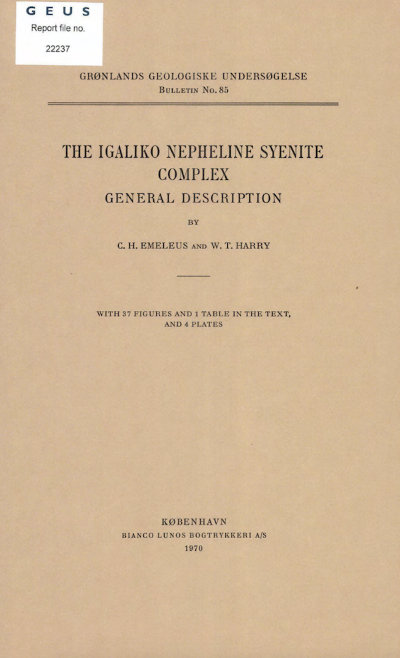The Igaliko nepheline syenite complex. General description
DOI:
https://doi.org/10.34194/bullggu.v85.6625Abstract
The Igaliko Nepheline Syenite Complex is in the Julianehåb District of Southern Greenland, at about 61°N and 45°W. The syenites and related rocks cover an area of about 450 square kilometres in the country between Tunugdliarfik and Igaliko Fjord on the west, and the Inland lce to the east. The Complex belongs to the group of Precambrian igneous intrusions, comprising the Gardar 19neous Province, exposed in the country around Ivigtut and Julianehåb. The Complex comprises four distinct intrusive centres, termed, in order of decreasing age, the Motzfeldt Centre, the North Qoroq Centre, the South Qoroq Centre and the Igdlerfigssalik Centre. With these are associated a number of small satellitic syenites which generally pre-date the rocks of the main centres of activity and numerous alkali trachyte and Big Feldspar Dykes, which, for the most part, belong to the regional Mid-Gardar swarms. The satellitic syenites and the three earlier syenite centres are earlier than the Mid-Gardar dykes swarms. Three members of the Igdlerfigssalik Centre are also earlier than the dykes but the four late intrusions in this centre cut the majority of the dykes. Each centre is made up of several intrusive members; including satellitic intrusions, the Complex consists of 28 separate units as well as several small dykelike bodies of syenogabbro and alkali gabbro. Within each centre the individual intrusions have arcuate, steep-sided outcrops with discordant, intrusive relations towards earlier members although, occasionally, there is evidence that petrographically and texturally distinct syenites were intruded at only short intervals thus possibly representing rapid pulses of magma from the same source. The mineralogy of the syenites is usually simple: perthitic alkali feldspar, nepheline and alkali pyroxene are the dominant minerals; these are accompanied by fayalitic olivine, alkali amphibole, biotite, magnetite-rich opaques, analcite, natrolite and apatite. Pegmatites are not numerous, but the Complex does contain the celebrated Narssârssuk pegmatite which lies within the outer member of the later group of syenites in the Igdlerfigssalik Centre. Except where locally contaminated by assimilation of country rocks, the Igaliko syenites are all nepheline bearing; the commonest type is foyaite. The quartz syenite – alkali gabbro intrusive of Klokken, about 5 km south of the Complex, is not regarded as a satellite. Igneous layering and mineral lamination are common internal structures in the syenites. These generally define concentric, inward-dipping structures within individual intrusions; the frequency with which the well-developed internal structures in one syenite may be sharply truncated by a later syenite indicates that, in some instances, an appreciable amount of time must have elapsed between successive intrusions. The structures found in the Igaliko syenites are identical with those described from other layered alkaline, basic and ultrabasic intrusions. 19neous activity within the Complex began at least as early as the Mid-Gardar. Syenites of the earliest centre intrude sediments, agglomerates and lavas belonging to the Eriksfjord Formation and also cut a dolerite dyke which may belong to the relatively early Gardar dyke swarm. The early Østfjordsdal Syenite (pre-South Qôroq Centre) cuts a small swarm of nepheline porphyry dykes. The dykes of the Mid-Gardar swarms maintain their regional WSW-ENE strike throughout most of the Complex except near Qôroq where there is a marked swing into a more northerly direction. Two major sinistral faults, striking ESE and east-west, displace the earlier centres of the Complex and the dykes. The faults are members of a regional set developed throughout southern Greenland. Since no alkaline dyke cuts the younger of the two faults, it is considered likely that the 2 km sinistral transcurrent movement of this fault post-dates the late syenites in the Igdlerfigssalik Centre; the late syenites are cut by a number of alkaline dykes petrographically identical with those displaced by the sinistral faults. Thus, the latest syenites at Igaliko may be of slightly earlier date than the later members of the Ilímaussaq Intrusion and the Central Complex of Tugtutôq, although still belonging to the Late-Gardar group of intrusions.
Downloads
Published
How to Cite
Issue
Section
License
This article is distributed under a CC-BY 4.0 licence, permitting free redistribution and reproduction for any purpose, even commercial, provided proper citation of the original work. Author(s) retain copyright over the article contents.


